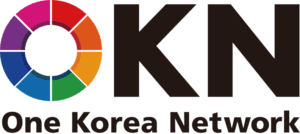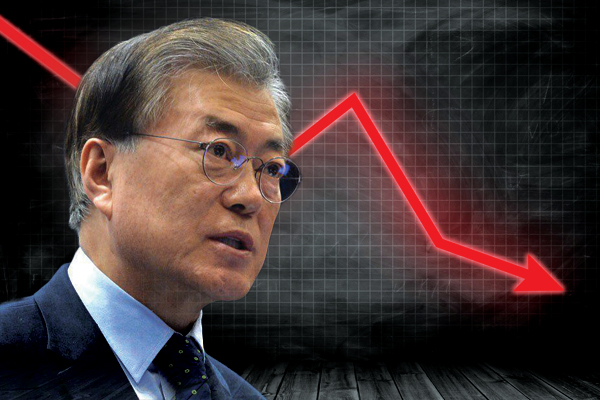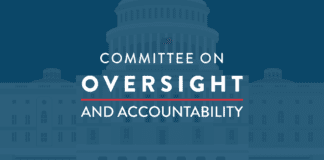May 10 marks the fourth anniversary of President Moon Jae-in’s inauguration. By this point, most South Korean presidents have seen their approval rating drop to the lowest level of their five-year term, which is often called the “president’s curse.” It appears that Moon is doomed to follow the same path. According to the latest Gallup Korea poll results, President Moon’s approval rating is 34 percent. It rebounded after it dropped below 30 percent for the first time last week.
Moon Jae-in’s 34 percent approval rating during his fourth year is the highest compared to his predecessors. The figure for former presidents Roh Tae-woo (12 percent), Kim Young-sam (14 percent), Kim Dae-jung (33 percent), Roh Moo-hyun (16 percent), and Lee Myung-bak (24 percent) were all lower than Moon’s current approval rating. Former President Park Geun-hye’s fourth year approval rating was excluded from the latest study by Gallup Korea, as her impeachment case was passed by the National Assembly and was under review by the Constitutional Court at that time in her term.
Moon Jae-in’s approval rating started at an all-time high of 84 percent in the first week of his term. It was even higher than the 83 percent approval rating of former President Kim Young-sam at his peak. However, Moon’s high approval rating has disappeared, and many political commentators in South Korea argue that they do not see a path for comeback, since the key reasons for the negative assessment of Moon cannot be solved within a year. People cited the government’s policies toward the real estate market, Covid-19, and other issues related to the economy as the reasons behind the negative assessment.
Starting from President Roh Tae-woo, who was the first democratically elected president, every president experienced a similar trend in their approval rating. All presidents began their first year with a high approval rating of around 60 to 80 percent, the figure would fluctuate during the middle of their term, and finally they left office with an approval rating of around 20 percent.
Former presidents Kim Young-sam and Park Geun-hye are the key examples of this trend. Kim ran as a presidential candidate from the conservative party, and declared himself to be South Korea’s first civilian president. The approval ratings of Kim and Park hit a peak in the first year of their terms. Kim dissolved the power held by military elites and had 83 percent support. The Park administration disbanded the leftist Unification Progressive Party, and put its senior officials on trial for treason. The court ordered the breakup of this pro-North Korea left-wing party. Her approval rating rose to 67 percent during the first year.
However, the international financial crisis hit South Korea in 1997 and the Kim Young-sam government had no other option but to ask for help from the International Monetary Fund (IMF). He left office with a 6 percent approval rating due to the economic crisis.
President Park Geun-hye was hit with the so-called “meddling in state affairs” scandal in her fourth year in office. She was impeached by the Constitutional Court, while her approval rating fell as low as 4 percent. Although not drastic a swing as Kim and Park, conservative President Lee Myung-bak started his term with 52 percent approval and left the office with 23 percent support.
Moon Jae-in, on the other hand, is a little different from his predecessors. He was the first president to win in a presidential by-election, which was held because of Park’s impeachment. Moon’s approval rating of 84 percent recorded in the beginning was some 10 to 20 percentage points higher than that of his predecessors during the same period.
His approval rating never fell below the 60 percent level, even after a year into his term. He had strong backing from his core supporters, and was able to maintain the 40 percent level even during big controversies surrounding his appointees that would have dragged down the approval rating of other presidents.
There were two major elections during the Moon administration, and his approval rating was very high on both occasions. During the regional elections held in June 2018, Moon’s approval rating was at 79 percent, largely thanks to the historic inter-Korean summit and the summit between U.S. President Donald Trump and North Korean leader Kim Jong-un. Many people believed that peace on the Korean peninsula was within reach. As a result, the ruling Democratic Party swept the election.
In April 2020, a general election to select members of the National Assembly was conducted. Moon’s approval rating, that had been languishing, jumped to 62 percent right before the election. Observers speculated that many people thought the government was responding well to Covid-19. The government also issued stimulus checks worth around 1 million won to potential voters for the first time in history. The ruling party won an overwhelming number of seats.
However, Moon’s approval rating plummeted nearly 30 percentage points since last year’s general election. “I believe that it is because the government and the ruling party have misinterpreted what the public really wanted to say through the general election,” said Chung Han-wool, a researcher at Hankook Research. “According to the survey conducted after elections, the public chose the ruling party as they wanted to have a stable economy and daily livelihood, but the ruling party continued to try to go against this.” In fact, the government and the ruling Democratic Party tried to push ahead with various “reforms” of the prosecutors service and the media, as if they were the most important issues for them. Opponents complained the administration’s “reforms” were in fact attempts to exert undue control over the prosecutors and the muzzle press outlets critical of Moon and his administration.
President Moon’s political mentor Roh Moo-hyun had a different experience. His approval rating fell to its lowest level of 12 percent in his fourth year, but the figure went up to 27 percent when he left office. This was the only case of a South Korean president’s approval rating recovering during his last days in office. One of the main reasons for the recovery at that time was a free trade deal signed with the United States. Liberals, who were key supporters of Roh, criticized the government’s plan, but Roh pushed ahead with it and signed the agreement in a year and a half.
The main opposition People Power Party (PPP) released statements ahead of the fourth anniversary of President Moon taking office, and asked him to apologize for what they called hypocrisy, greed, and use of double standards.
“The supreme leader of the country begins as the leader of his party and ends as the president of all people, but President Moon started as president of the Democratic Party and tried to end his term as president of the strong pro-Moon supporters,” said Cho Hai-jin, a lawmaker from the PPP who is running for party leader. “I hope that President Moon stops believing in his strong supporters, because it will be a poison for someone who believes in it, since they will all collapse together in the end.”
Bae Joon-young, a spokesperson from the PPP, argued that “there are many people who think that this administration is traveling in a 40-year long tunnel instead of a 4-year one.”
“People’s hope of having their own home has become more unrealistic, due to 25 wrongly-directed real estate policies and some 1.95 million jobs that have disappeared due to (Moon’s) nonsense policy called income-led growth.”
Bae added that the government policies should be focused on direction rather than speed. “If the leader realized that the direction was wrong, it is the leader’s resolution to change the direction to prevent the Republic of Korea from falling into a bottomless pit.”



